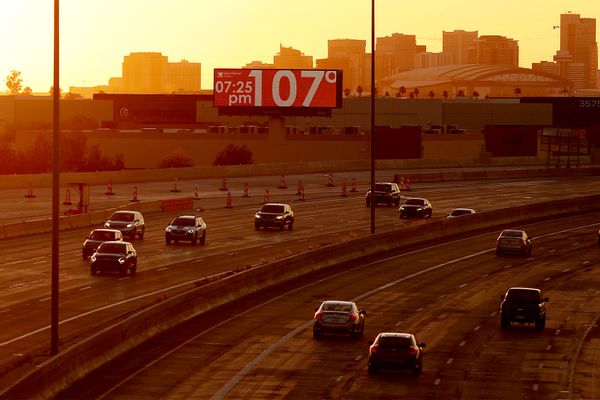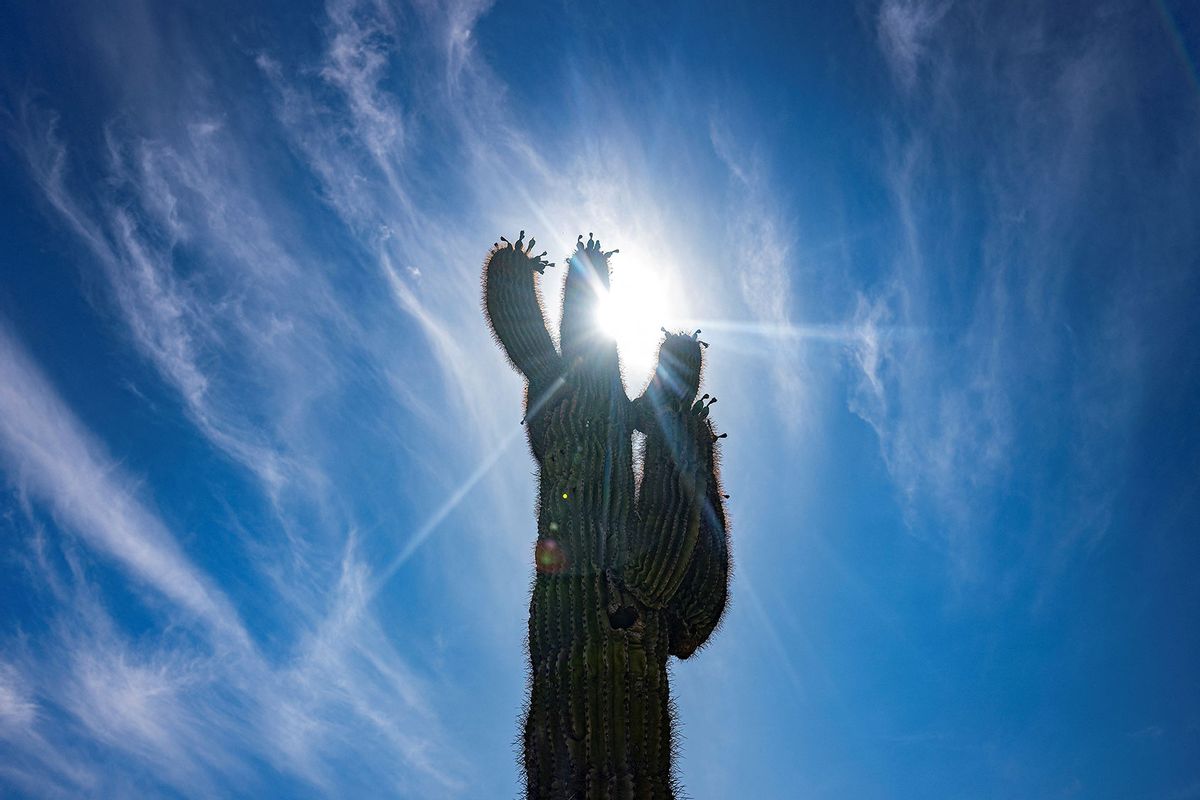For millions of Americans in the Southwest, the extreme heat from climate change is a literal life-and-death matter. Just ask Amy Dishion, whose 32-year-old husband Evan unexpectedly died from the heat while hiking six miles with friends in Phoenix. Dishion was left to raise their three-month-old baby.
“I lost my partner in life and my favorite person and the father of my child to extreme heat because he went on a hike during hot weather," Dishion told Salon. “My life is never going to be the same. It’s been incredibly difficult and I’m not sure how I’m ever going to bounce back from this loss. Evan is someone no one would have expected this to happen to. He was extremely fit, he was a marathon runner in the prime of his life. My husband was exceptional — he overcame so much to become a physician. And now, because of the heat, he doesn’t get to see his baby girl grow up and I’m left to pick up the pieces.”
Even when it's not deadly, the heat has a way of diminishing the quality of life for people in the desert. Hazel Chandler, a 77-year-old Arizona field organizer for the climate advocacy group Moms Clean Air Force, lives in Phoenix with stage-four cancer and has many other health issues that make her especially sensitive to heat. As a result, when goes outside she has to bring oven mitts with her in case she is forced to touch metal railings, since the metal will burn her hands.
“My metal internal spinal fusion heats up when I’m outside for even a minute or two and feels like someone is holding a hot poker on my spine,” Chandler said. “Two summers ago, the air pollution was so intense that I coughed so much I fractured my spine. We must take heat safety seriously and do everything we can to clean up the air we breathe ”
There are no doubt many other stories like Dishion’s and Chandler’s which are simply not known to the general public. The American Southwest has been experiencing unprecedented heat waves throughout 2024, due in large part to human-caused climate change. Even when the heat is not at its peak, it can still be cruel for those stuck in it.
"Many areas of the country are predicted to experience many more dangerous heat days per year."
Lisa Materna and her husband moved from one Arizona city to another in July — specifically, from a third story apartment in Goodyear to a single story home in Glendale — and did not expect an arduous move because it had not yet hit peak temperatures in the Phoenix metropolitan area’s West Valley. Yet they moved right at the start of the monsoon season, with high humidity and 100 degree temperatures.
“We had no elevator, and I was little to no help as I had just found out I was pregnant and the first trimester nausea had hit bad,” Materna recalled. “My husband, God bless him, moved 90% of our apartment down those three flights of stairs by himself. There were moments of exhaustion and dehydration, but all you can do is take your time, schedule a good time of day to move (preferably early morning as nights are still 90+ degrees) and have tons of water on hand.”
Want more health and science stories in your inbox? Subscribe to Salon's weekly newsletter Lab Notes.
Four months later and the Maternas still find it to be too hot to comfortably unpack their home. “Our goal is to get to everything these next few weeks now that it's cooled down,” Materna recalled.
Between June and August 2024, 26 major American cities had at least one dangerous extreme heatwave. According to Climate Central, anthropogenic climate change is so extreme that one out of four people on Earth received no relief from climate change-driven heat in summer 2024. On Aug. 13, global exposure peaked when half of all living people — 4.1 billion human beings were forced to undergo “unusual temperatures made at least three times more likely by climate change.”
This problem is especially prevalent in the Southwest, as epitomized by the Phoenix metro area. Maricopa County, the most populous in the state, has 4.5 million residents and is the fastest growing county in the United States. Roughly 400 Arizonans died from heat throughout 2023, many in Maricopa County, with some climate activists urging fossil fuel companies to be held legally accountable for these deaths. As humans continue to burn fossil fuels for transportation, manufacturing and agriculture, carbon dioxide and other greenhouse gas emissions trap heat and unnaturally warm the planet.
If you live in the Southwest, chances are you are acutely aware of this. According to Juan Declet-Barreto, a senior social scientist at the Union of Concerned Scientists, this is because living in a desert while the Earth unnaturally heats up creates many logistical problems.
"This is a timebomb and nobody is doing anything about it."
“Climate change is threatening water resources, increasing challenges to food and fiber production, and compromising human health in the Southwest through drought, wildfire, intense precipitation, sea level rise, and marine heat waves,” Declet-Barreto said. “These changes are affecting ecosystems, infrastructure, agriculture, fisheries and other economic sectors. Effective adaptation will require flexible decision-making and the incorporation of technological innovation with Indigenous and local knowledge.”
Declet-Barreto explained that as extreme heat increases in the Southwest, there is a high probability of “drought, flooding and wildfire activity,” as well as climate change “shaping the demographics of the region by spurring the migration of people from Central America to the Southwest.”
People who are poor, elderly and work outdoors will be especially vulnerable to suffering from health problems as a result.
“This year during what we at [the Union of Concerned Scientists] call Danger Season, we saw many heat and wildfire events in the [Southwest],” Declet-Barreto said. “Rescue choppers could not fly to rescue motorcyclists in Death Valley because it was too hot,” nearly 130º F.)
Because humans have failed to significantly curb greenhouse gas emissions, these conditions are only going to get worse in southwestern states like Arizona.
 A billboard shows the current temperature over 100 degrees on June 05, 2024 in Phoenix, Arizona. According to the National Weather Service, Phoenix will experience record temperatures over 100 degrees as a pattern of high pressure builds over the region. (Justin Sullivan/Getty Images)Even people without dire health conditions are suffering from the intensified heat. Jackie Grinder, a 48-year-old marketing professional who lives in midtown Phoenix, told Salon that she has “seen it get hotter and hotter, and have seen how little — as in nothing — the cities here have done to combat it or help citizens deal with it. In fact, they have contributed to it, doing nothing but adding more concrete, taking out greenery, and allowing utilities to hike prices over and over to the point where you can pay $500 to $700 a month just to keep your house a bit below 80 in the summer.”
A billboard shows the current temperature over 100 degrees on June 05, 2024 in Phoenix, Arizona. According to the National Weather Service, Phoenix will experience record temperatures over 100 degrees as a pattern of high pressure builds over the region. (Justin Sullivan/Getty Images)Even people without dire health conditions are suffering from the intensified heat. Jackie Grinder, a 48-year-old marketing professional who lives in midtown Phoenix, told Salon that she has “seen it get hotter and hotter, and have seen how little — as in nothing — the cities here have done to combat it or help citizens deal with it. In fact, they have contributed to it, doing nothing but adding more concrete, taking out greenery, and allowing utilities to hike prices over and over to the point where you can pay $500 to $700 a month just to keep your house a bit below 80 in the summer.”
Grinder added that every year she has seen less rain, more dust and skyrocketing electricity rates as residents try to keep cool.
“This is a timebomb and nobody is doing anything about it,” Grinder said. “In the meantime, the citizens pay taxes and suffer.”
The ticking clock may be more conspicuous in the Southwest because it already experiences very high temperatures through much of the year, but it is hardly limited there. Peter W. Reiners, a professor of Geosciences at the University of Arizona, explained that this region is not actually warming faster than certain parts of the American Northeast and Alaska.
“The kind of temperature we normally associate with extreme heat (dry-bulb temperature) is only part of the story and may be misleading us about where the worst threat from warming really is,” Reiners said. “Although there is some debate about whether dry or humid heat (as measured by wet-bulb temperature) will kill more people in our warming world, it is clear and ‘scary as hell,’ that high wet-bulb temperatures have the potential to make large parts of the world — parts where enormous numbers of people now live — uninhabitable much of the time.”
From the northeast to the southwest and for large areas in between, the extreme heat will test human adaptability to its limits.
“The human toll and threat of massive geopolitical disruption from its increasing frequency and intensity is a truly scary prospect,” Reiners said. “Even in the U.S., I think it is underappreciated that many areas of the country are predicted to experience many more dangerous heat days per year, as measured by wet bulb temperature. [They] are not in the Southwest, but in the Southeast, East Coast, and much of the Midwest.”
But people can still adapt to the rising heat. Reiners pointed out that narrow streets tend to reduce the amount of heat people experience, trees and vegetation can cool the environment through “evapotranspiration” while providing shade and painting roofs and materials white increases albedo (the sunlight reflected into space) so the people there experience less heat. Yet these mitigation measures can only accomplish so much; aside from reducing carbon emissions, there is no way to turn back the clock on the heat.
We need your help to stay independent
Similarly, it would be a mistake to assume that people can simply escape climate change by avoiding obviously hot areas like the Southwest. As Reiners pointed out, climate change will impact you no matter where you live.
“There is a danger in channeling all our (very well-founded and legitimate) anxiety about climate change into some kind of comfort from scorning the supposedly more ignorant people living in places with extreme heat,” Reiners said. “The smug sense that only people in places like Phoenix are susceptible to the dangers of global warming is just wrong. As warming-fueled weather disasters and wildfires increase around the world (and just look at Vermont, North Carolina, Canada as a few examples) should be making crystal clear, there is no refuge from climate change.”
Materna understands this all too well. She has already seen how her quality of life has changed because of the heat.
“There are laws in place for pets not to be walked when temps hit 95 degrees,” Materna said. “Outdoor time is limited for students when it gets too hot. Most people here have learned to avoid going outside during those hot days. You acclimate. Find a friend with a pool, and carry water everywhere.”
She added, “My heart goes out to the unhoused, as there is little to no relief when those temps rise.”
Read more
about climate change



Shares